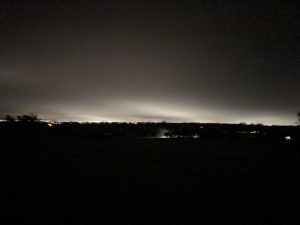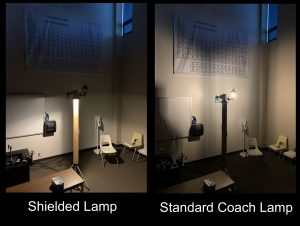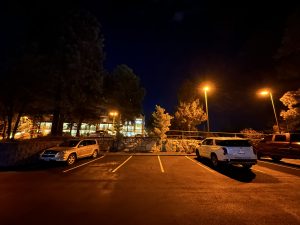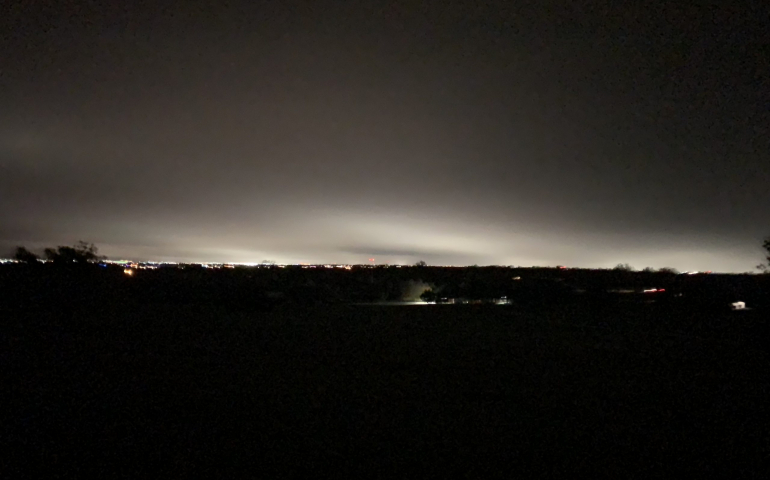By Ty Gschwandtner with contributions by Travis Vernier, MD
——————————————————————————————————————————————————————————————————-
“The heavens are telling of the glory of God.” – Psalm 19:1, NASB
It’s 11:56 pm, and I’m walking back to my dorm room from the library after a long study session. As I pass the Everlasting Torch, which is unlit, I happen to glance up at the sky. Despite how dark it seems on campus, only three or four stars twinkle above me – the rest of the sky is pitch black. But the night sky wasn’t always this empty – it used to be full of stars. In fact, it used to be so full of stars that the Milky Way itself would cast shadows under a new moon. The reason for the change is an under-appreciated type of pollution: light pollution.

Light pollution is any kind of wasted light – light that isn’t really being used and is just there. Streetlights, porch lights, and even lights from houses and buildings shining out of windows all count as light pollution. All this light spreads out into the night, bounces off the atmosphere, and comes back to us. This creates a type of light pollution known as sky glow, which is so bright that it overpowers starlight and makes the universe beyond our world invisible to the naked eye.
In 2001, John Bortle, an American amateur astronomer, devised the Bortle Scale to help astronomers gauge light pollution. His scale has 9 “classes.” A Class 1 sky is the clearest sky you can get. These places are so dark during a new moon that the Milky Way is visible to the naked eye and even casts shadows, some distant galaxies are visible to the naked eye, and it is difficult to pick out constellations because of how many stars there are. Every human with the gift of sight who lived prior to the invention of electric light was able to see a sky like that. In fact, it is likely that your grandparents or great-grandparents witnessed skies like this when they were young. Now, however, there is only one place in the entire state of Oklahoma where you can see a class 1 sky: Black Mesa State Park, which is a distant five-and-a-half hours from central Oklahoma.
The good news is that not all is lost. Light pollution can be reversed as easily as flipping a switch. In fact, this happened during the Northridge Earthquake that knocked out Los Angeles’s power grid in 1994. When night came after the earthquake, a glowing cloud was visible in the sky, and it startled some residents so much that they called the Griffith Observatory to understand what they were looking at. It was the Milky Way, restored to visibility at the flip of a switch.
Now, you may be thinking, “But we need light!” You’re right. We need to be able to see when we drive. We need them around our homes, businesses, and roads for safety. This is all true. The good news is that a dark sky does not mean a dark ground.
DarkSky International and other leading night sky preservation authorities have devised lighting strategies that balance the needs of modern civilization while preserving the night. These recommendations include two important points: using lights with shields that prevent light from going up, and using warmer, redder light wherever appropriate.

Shielded light fixtures are widely available at most hardware stores if you look for them. These lights are designed to not allow light to shine above the horizontal, as depicted on the right thanks to a demonstration by Dr. Vernier on SNU’s campus in 2022. These lights dramatically reduce sky glow and increase ground visibility without any extra energy use because all of the bulb’s energy gets projected downward where it is useful.
In addition, the color of the light bulb matters. Instead of “cool white” or “bright white,” LEDs, which give off large amounts of blue light that substantially increases light pollution, use warmer, redder colors. Most of us have probably heard that the blue light from our phones can knock our circadian rhythms off and make it more difficult to sleep. The lights shining through your window do the same thing. Using warm or red light is like setting the world to “night mode.” Not only will it allow you to sleep better, but redder light can also increase nighttime visibility because it causes less glare and allows your natural night vision to turn on.

Some cities have implemented these strategies and others to preserve their night skies. In Flagstaff, Arizona, a university town of more than 78,000 people, for example, found that it is possible to see the Milky Way from any part of the city. These strategies work, and they have no side effects, such as increased crime or traffic collisions, when implemented properly.
As I continue walking back to my dorm, I can’t help but wonder what I would see if SNU switched to shielded, redder lights instead of the ones we have now. What if our change would help lead Oklahoma to become a state dedicated to the protection of our skies? What planets and constellations could I make out? Would I be able to see the Milky Way? We won’t find out until change comes though – and I sincerely hope it will.
Photos by Travis Vernier
References:
https://www.go-astronomy.com/bortle-class-1-sky-sites.php
https://skyandtelescope.org/observing/how-dark-is-your-night-sky/
https://www.go-astronomy.com/dark-sky-parks-stargazing-state.php?State=OK
https://outdoorswire.usatoday.com/2023/02/09/light-pollution-map-bortle-scale/
https://en.wikipedia.org/wiki/Red#In_science_and_nature
https://www.thevintagenews.com/2018/02/08/northridge-earthquake-1994/
